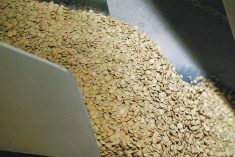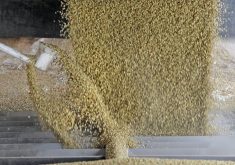Global lentil production was up about 17 per cent last year, but demand has kept pace.
Market analyst Marlene Boersch told a Saskatchewan Pulse Growers meeting that the production numbers might suggest the world is “drowning in lentils,” but that isn’t the case.
“When I look at global production and exports and imports, you see that we have a steeply rising production driven by Canada and Australia, but imports have been increasing accordingly,” she said. “So we have a very well-functioning market.”
Read Also

Fertilizer method’s link to emissions studied
A researcher says others studying greenhouse gas emissions aren’t considering how the loss of nitrogen into the atmosphere correlates with fertilizer application or if there is an impact to yield.
Boersch said lentil demand has been strong for the last three years. The red lentil market was able to absorb 1.2 million acres of production from Australia, and the green lentil market had strong pent-up demand and an inelastic market.
“We have maintained some very good prices in spite of competition from Russia and Kazakhstan,” she said.
Canadian production was about 2.5 million tonnes last year, while Australia came in at 1.7 million tonnes.
India is the third largest producer but also the most important importer.
Boersch said production in Kazakhstan has dipped but is slowly returning. Profitability has been difficult and there are quality issues with the crop. She said most of the crop is shipped to Turkey for processing, which is an expensive endeavour.
The United States, which produces mostly green lentils, produced a record 410,000 tonnes last year; ending stocks are expected to be fairly high at 140,000 tonnes.
Boersch said the Canadian balance sheet shows lentil numbers are not burdensome, but the longer-term problem is losing market share.
“It’s always good to have a high market share because then you’re very determinant when you set the prices,” she said.
Canadian lentil acreage is expected to be up one per cent, according to Agriculture Canada, although Boersch is estimating it will increase two per cent to 3.28 million acres. She said rotations and disease can outweigh some of the price signals.
In 2024-25, Canada is expected to export about two million tonnes. India and Turkey are the major importers.
However, this is where Boersch starts to worry. She said Canada often thinks of lentil markets as stable, but that isn’t true when each country is examined individually. Imports by both India and Turkey can fluctuate significantly because both are also large producers.
“If you look at some of the major destinations, it takes a lot of work to balance out at the end of the year. It’s not a given,” she said.
Canada is fortunate to have many markets for both red and green lentils to allow the export picture to even out, she said.
Year-to-date data shows 42 per cent of the projected two million tonnes of exports has moved. Increases to Turkey, India and Pakistan are noted, while shipments to Bangladesh are down.
However, when looking at market share, she said that in 2019, India purchased 823,000 tonnes of lentils, and 486,000 tonnes of those were from Canada for an 82 per cent market share.
As of July 2024, India had bought 545,000 tonnes with 174,000 tonnes from Canada, or a 32 per cent market share.
The story is similar with Turkey, where market share went from 82 per cent in 2020 to 52 per cent this past October.
“These are very substantial changes in market share in our major markets,” Boersch said.
In the pea industry, global production is almost unchanged, but Russia has become the biggest producer and competitor, increasing its exports significantly after China began buying. Canadian markets for peas are less diversified than lentil destinations.
“The demand for edible peas has been fairly solid, but for feed it’s very price dependent and we haven’t really seen a lot of demand,” Boersch said.
Indian demand saved yellow peas in the fall but that is slowing, she said.
Russia produced 4.3 million tonnes of peas in 2024, or about 37 per cent of total global production, followed by Canada at three million tonnes or 26 per cent.
The European Union is a fairly big user of peas and produced 2.1 million tonnes last year, up nine per cent, while U.S. production dropped to about 756,000 tonnes despite more acreage because of low yields.
Canadian production was up 15 per cent last year and exports should remain steady, she said. Ending stocks will creep up to between 100,000 and 200,000 tonnes.
Exports of yellow peas to China have been tepid, and India has not yet opened quotas. That compares to last year when Canada had already shipped 680,000 tonnes to India by the end of November.
Canada typically exports between 7,000 and 18,000 tonnes of peas each month to the United States. On average, the U.S. market represents seven percent of total pea exports. Boersch said India, China and Bangladesh have been buying more, but the proposed 25 per cent tariff will have an impact.
China is mostly buying green peas from Canada, which is why that market is strengthening compared to yellow peas.
Boersch’s concern about market share also exists with peas. She said Canada supplied 98 per cent of China’s pea imports just three or four years ago, but that is down to 42.4 per cent from January to November 2024.
“I think most people here don’t realize that the market shares have changed a lot because we look at overall tonnage and the tonnages haven’t changed so much,” she said.
“What it really tells us is that the market has grown, but we haven’t been able to grow with the market, and that has a price effect.”
Agriculture Canada is forecasting a two per cent increase in pea acreage this year to 3.27 million acres. Boersch said she expects increases will focus on green peas because of the price advantage.
Global production of kabuli chickpeas is down, especially for large calibres.
Boersch said the market is tricky because Canada is a peripheral player. Russia is increasingly competitive, she added, although it grows smaller calibre kabulis than Canadian growers.
The U.S. tariffs are likely to be detrimental because the U.S. took more than 25 per cent of Canadian chickpea exports over the last year. It buys between 3,000 and 8,000 tonnes of Canadian chickpeas each month, and Boersch said the tariff presents a sizeable problem.
Mexico is also a competitor, but its production is behind its 2018 highs. Production in Canada and the U.S. is also up.
Boersch said poor growing conditions in Mexico have affected its ability to export kabuli chickpeas, and its asking prices are up. This is a big influence on North American markets, she said.
Chickpea bids have softened a bit, and Boersch said that’s likely due to payment problems in India for desi chickpeas.
Canadian acreage has increased, and she said it could be up from the 479,000 acres planted in 2024.
Contact karen.briere@producer.com


















